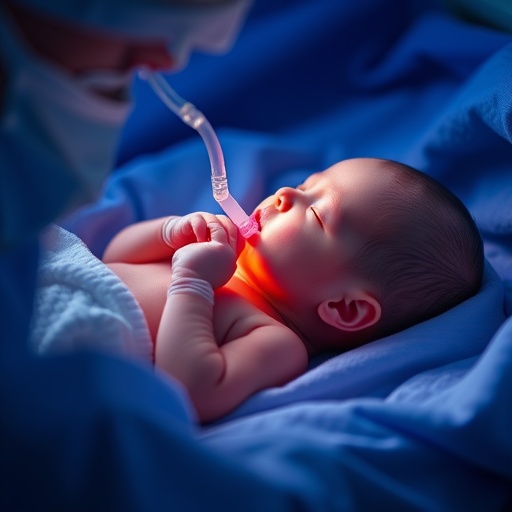Endotracheal intubation remains a critical intervention for preterm infants diagnosed with evolving chronic lung disease (CLD), a condition characterized by persistent respiratory insufficiency following premature birth. However, the necessity and risks associated with endotracheal tube exchange in this vulnerable population have long been topics of clinical debate. A groundbreaking study recently published in the Journal of Perinatology delves deep into the safety profile and pulmonary mechanical consequences of endotracheal tube exchange in preterm infants battling CLD. This extensive research not only elucidates the procedural risks but also highlights the nuanced impact on respiratory mechanics, paving the way for more informed and evidence-based clinical decisions.
The central premise of the research addresses the clinical conundrum faced by neonatologists when confronted with a malfunctioning or malpositioned endotracheal tube in infants with delicate pulmonary physiology. While tube exchange is occasionally imperative to restore or optimize ventilation, there has been scant quantitative data regarding its safety and potential repercussions on pulmonary function in this fragile patient group. By systematically analyzing a cohort of preterm neonates undergoing tube exchange, the investigators provide a comprehensive evaluation of peri-procedural stability, incidence of adverse events, and shifts in lung mechanics following the intervention.
The study methodology involves meticulous monitoring of pulmonary parameters such as tidal volume, compliance, and resistance pre- and post-endotracheal tube exchange. Using sophisticated pulmonary mechanics measurement tools adapted for neonatal intensive care units, researchers achieved high-resolution insight into the immediate physiological perturbations that can arise from the intervention. Such detailed data collection surpasses prior anecdotal or observational accounts, offering an empirical foundation to characterize the true impact on pulmonary function.
One of the most striking findings from the study is the affirmation of tube exchange’s relative safety under stringent procedural protocols. Despite inherent risks associated with airway manipulation—such as transient hypoxia, bradycardia, or accidental extubation—the data demonstrated that, when performed by experienced clinicians, endotracheal tube exchange did not result in statistically significant increases in adverse events. This revelation should empower NICU teams to approach tube exchange with measured confidence when clinically indicated, although it equally underscores the necessity of meticulous technique and promptly available resuscitative support.
In addition to safety considerations, the research probes the intricate alterations in pulmonary mechanics attributable to tube exchange. The study documents a transient decrease in lung compliance immediately following the procedure, suggesting that even brief airway disruption can affect alveolar recruitment or surfactant distribution in the immature lung. Importantly, these changes were typically temporary, with pulmonary mechanics trending back towards baseline within hours. This dynamic reflects both the resilience and vulnerability of premature lungs, signaling that clinicians should prepare for potential transient respiratory support adjustments post-exchange.
The investigation further reveals that tube size optimization during exchange plays a pivotal role in post-procedural respiratory outcomes. Infants who underwent tube upsizing often manifested improvements in tidal volume and overall compliance. Conversely, exchanges that maintained suboptimal tube diameters correlated with persistently compromised pulmonary mechanics, emphasizing the critical nature of selecting appropriately calibrated endotracheal tubes to support evolving lung pathology in preterm infants.
Another dimension explored is the relationship between the timing of tube exchange and clinical outcomes. The study suggests that earlier intervention in cases of suspected tube dysfunction may prevent exacerbations of lung injury by maintaining more stable ventilation parameters. Delays in exchange could potentiate mechanical trauma or inflammatory responses due to inconsistent lung aeration patterns. This insight advocates for vigilant clinical surveillance and prompt corrective action in managing airway devices among high-risk neonates.
Furthermore, the implications extend to ventilator strategy modifications post-exchange. Given the observed alterations in pulmonary dynamics, the authors emphasize the importance of re-assessing and tailoring ventilator settings immediately following tube exchange. Adjustments in positive end-expiratory pressure (PEEP), inspiratory time, and pressure support should be guided by realtime pulmonary mechanics data to mitigate further lung injury and optimize gas exchange.
The research also sheds light on the need for robust training and standardization of endotracheal tube exchange procedures in neonatal intensive care units. Variability in operator experience and technique could influence both safety profiles and pulmonary outcomes. The authors advocate for protocolized training regimens, simulation-based practice, and multidisciplinary involvement to elevate procedural success rates and minimize complications.
Intriguingly, the study opens avenues for potential technological innovation. Enhanced endotracheal tube designs featuring sensors to monitor position and patency in real time could reduce the frequency of unnecessary exchanges. Additionally, minimally invasive exchange techniques or adjunctive airway devices may be explored to lessen physiological perturbations during tube replacement in this sensitive population.
The findings hold significant translational value beyond neonatology. Understanding pulmonary mechanics alterations induced by airway device manipulation in preterm infants contributes to the broader field of respiratory medicine, particularly in critical care scenarios involving mechanical ventilation. The data enrich the foundational knowledge base guiding airway management strategies in vulnerable lungs subject to varied pathologies.
Ethical dimensions surrounding invasive procedures in preterm infants are addressed as well. The study carefully balances the necessity of intervention against the potential for iatrogenic harm, offering evidence-based guidance to navigate these difficult decisions. Patient-centered approaches encompassing risk-benefit analyses and family-centered communication are recommended to optimize clinical care pathways.
Looking ahead, the authors call for longitudinal studies examining the long-term pulmonary consequences of repeated endotracheal tube exchanges in infants with evolving CLD. Elucidating the impact on lung growth, development, and ultimate respiratory function in childhood could further refine clinical protocols and foster developmental lung preservation.
The study’s robust dataset and rigorous analytic methods contribute a compelling argument for integrating pulmonary mechanics monitoring as a standard adjunct during airway management in neonatal intensive care. Real-time data acquisition not only supports safer procedural conduct but also enables individualized ventilatory optimization tailored to the infant’s evolving pulmonary status.
This research represents a critical advancement in neonatal critical care, bridging gaps in understanding and providing actionable insights that could revolutionize airway management strategies. By embracing scientific rigor and technological innovation, the neonatal community stands poised to improve outcomes for preterm infants with chronic lung disease facing the challenges of endotracheal tube exchange.
The study illuminates the dynamic interaction between airway instrumentation and fragile neonatal lung physiology with extraordinary granularity. It empowers clinicians worldwide to strike an informed balance between lifesaving interventions and the imperative to safeguard delicate pulmonary function—a true leap forward in perinatal medicine.
As preterm infant survival rates continue to improve due to advances in neonatal medicine, optimizing the quality and safety of respiratory support remains paramount. This pioneering work underscores the critical role of meticulous procedural care combined with sophisticated physiological monitoring to ensure these most vulnerable patients can breathe easier today and thrive tomorrow.
Subject of Research: Safety and pulmonary mechanical impact of endotracheal tube exchange in preterm infants with chronic lung disease.
Article Title: Endotracheal tube exchange in preterm infants with evolving chronic lung disease: safety, outcomes, and impacts on pulmonary mechanics.
Article References:
Parker, M., Shay, R., Weikel, B.W. et al. Endotracheal tube exchange in preterm infants with evolving chronic lung disease: safety, outcomes, and impacts on pulmonary mechanics. J Perinatol (2025). https://doi.org/10.1038/s41372-025-02411-0
Image Credits: AI Generated
DOI: https://doi.org/10.1038/s41372-025-02411-0
Tags: clinical decision-making in preterm careclinical implications of tube exchangeendotracheal tube exchange risksevidence-based neonatology practiceslong-term outcomes of tube exchangeneonatal intensive care unit interventionsneonatal respiratory insufficiencypreterm infants chronic lung diseasepulmonary function in preterm babiespulmonary mechanical consequencesrespiratory mechanics in neonatessafety profile of intubation procedures





